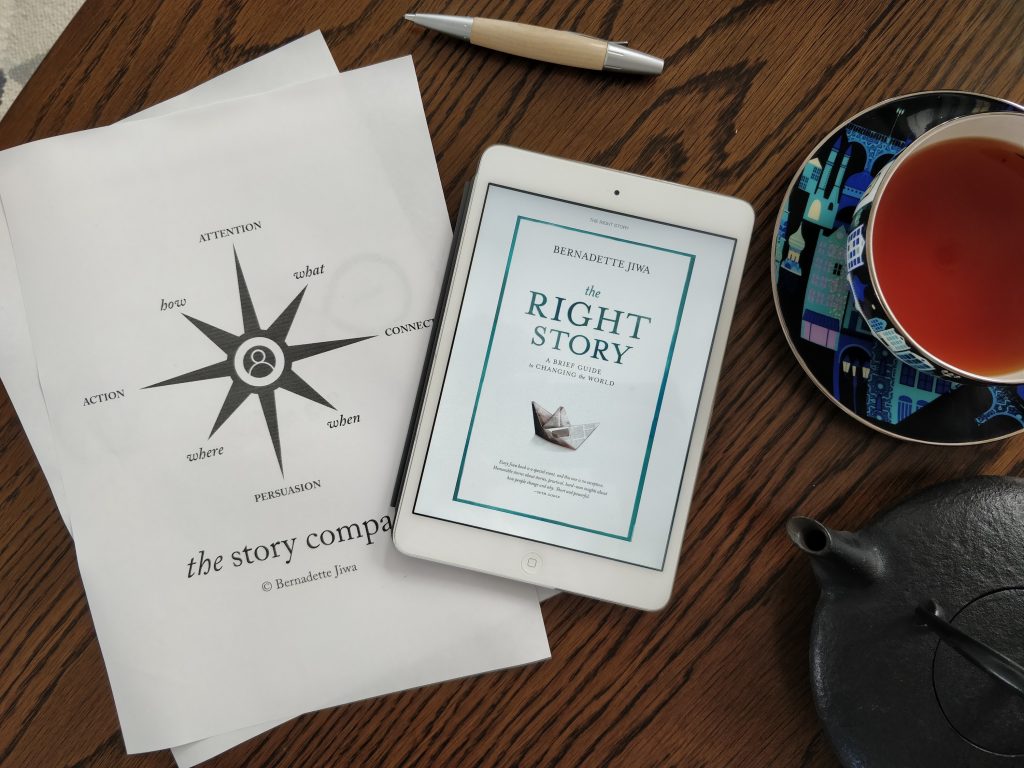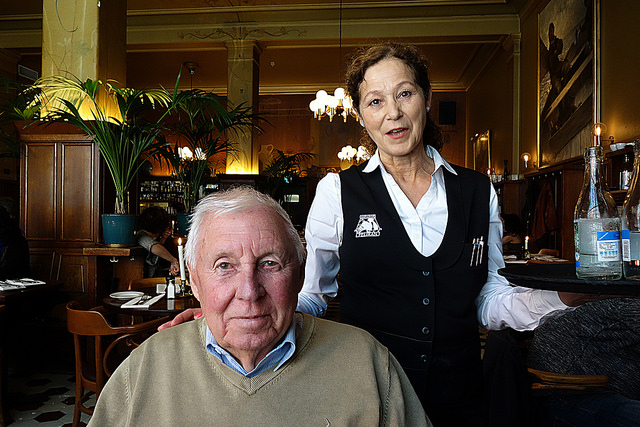Unlock the Magic in Your Story Now
Get the Free 20 questions to Ask Before Launching Your Idea workbook when you sign up for occasional updates.
Get the Free 20 questions to Ask Before Launching Your Idea workbook when you sign up for occasional updates.
Is Your Marketing Working?
filed in Marketing, Storytelling, Strategy

Last week I visited the local camping store to buy a gift card. As I was paying at the point of sale, a one question survey popped up on the keypad. The store manager asked if I’d seen their TV ad. When I said I hadn’t, she hit ‘no’ on the survey. I couldn’t resist asking her what percentage of people said ‘yes’. In her store, the answer was zero. In the time they’d been doing this survey the store manager hadn’t encountered a single paying customer who had seen the company’s TV ad. Not one.
Their marketing (or I should say, their advertising) isn’t working. And yet, the store was full of people buying tents for their camping trips down south, and warm jackets for their overseas skiing trips. The TV adverts are seen by hundreds of thousands of people. The problem is that those ads aren’t being seen by the right people. The camping company has discovered that more reach doesn’t equate to more resonance or more of the right customers.
Making more people aware that your product or service exists doesn’t mean your product or service will be more successful. It’s not enough to tell your story. You need to tell the right story to the right people at the right time.
The tools in my new book, The Right Story, now available for pre-order will show you how.
Image by Thomas Rousing
Share this article
The Right Story
filed in Marketing, Storytelling, Strategy

What makes some bad ideas successful, and why do many good ideas fail? It turns out that there’s no such thing as a bad idea or a good idea. There is only the wrong story or the right story. The right story is one that is trusted. It is believed because it is told by the right person, for the right reasons, in the right way, at the right time, to the right people.
The success or failure of our ideas depends on us telling the right story. We can only do that by being clear about the change we want to create, and why—and then bringing enough of the right people with us on the journey. It’s up to us, the changemakers of today and tomorrow, to galvanise those people we hope to bring on the journey with us.
That’s why I wrote my new book, The Right Story. Not just to help you to persuade people or get better at delivering your message. But also to give you the tools to help you understand what should drive that message.
The Right Story will help you to resonate with your right people and become a more purposeful and powerful communicator. You’re the reason I wrote it. You can preorder your Kindle copy today—paperback copies will be available next week. I hope it helps you and your good ideas to succeed this year.
Share this article
Be Ambitious

In our culture ambition is both celebrated and frowned upon—not always in equal measure. Ambition is encouraged and rewarded, but only to a point.
Perhaps it’s not ambition itself that’s the problem, but rather, our narrow definition of it? We aspire mostly to the ambition of accumulation. We want to be more and have more. More accomplished or influential, more wealthy or successful. Preferably all four. But if we’re asked to define success, we’re not always sure what it means to us.
If we’re going to find our calling, do meaningful work and live happy, fulfilled lives we need a more ambitious definition of success.
Be ambitious about the power and potential of your ideas. Be ambitious about the depth of the change you want to create. Be ambitious for the people you love and those you serve. Be ambitious for the people in your community who you’ve never met. Be ambitious for the children in your country who have yet to be born. Be an ambitious advocate for those who have lost hope.
Reflect on what you want. Then go after it with your head held high. And encourage and help others to do the same.
Image by Garry Knight
Share this article
Design For The Outcome You Want
filed in Strategy

When a once beloved brand under new management, repeatedly relies on flash sales and deep discounts to boost sales, it’s obvious that the organisation’s goal is to massage the numbers on the next quarter’s balance sheet. The leadership team are designing the business for the outcome they want—short-term growth, on paper. A short-term strategy doesn’t always take long-term effects into account. Discounting, in this case, sets off a chain reaction.
Customers who pay full price one day, only to see products discounted the next, are now educated to buy when products are discounted. There will always be another sale right around the corner, after all. So the brand loses its efficacy because the story the customers believe changes. The meaning customers once attached to the brand gradually erodes until the irreplaceable brand becomes an interchangeable commodity.
Every decision we make has a knock on effect. Today’s decisions impact tomorrow’s outcomes. We need to plan for then and now.
Image by Milo Baumgartner
Share this article
The Power Of What Goes Unnoticed
filed in Marketing, Storytelling, Strategy

The two sign installers stand back to assess their work before finishing the job. But something isn’t right. A couple of the large adhesive letters they have applied to the storefront window are crooked, and one of the men calls this out. His colleague agrees. The sign is definitely looking a little wonky. But, he reasons, if the store owners don’t care about fonts, they aren’t going to notice this.
‘Let’s just crack on with it,’ he says.
And they do. But something else is not right—something that skips his attention, as he turns to get the rest of the equipment from their van. His colleague’s smile slips, his shoulders slump. Even though he agrees that the store owner might not notice the sign isn’t perfect. He knows. And that knowing sucks all the joy out of the work.
We are not only showing up for customers. We are showing up to ourselves—to do work we’re proud of, even when no one is watching.
Image by Peter B
Share this article
Forget Marketing
filed in Marketing, Storytelling

Forget marketing. Instead, sit down and reflect on what you want your customer to know about why you’re building what you’re building. Tell them everything. Write it down.
Start with how you got to this moment and how your journey to it has equipped you to help them. Tell your customers how you’re going to help and why it matters that you do. Then show them how their lives will be better because of what you created. Remind them what’s at stake.
Marketing doesn’t have to be about promoting and pitching. Marketing can be an honest conversation between two people (or groups of people), who need each other.
Image by Garry Knight
Share this article
More Customers Vs. More For Customers
filed in Marketing, Strategy, Success

Every business begins with the founder’s intention about the outcome he or she wants to achieve. Every aspect of its development stems from that original intent.
As businesses owners, leaders and creators, we can adopt one of two strategies. We can build a business with the intention of getting more customers, or we can want more for our customers.
The outcome we want shapes the kind of business we build.
And the flip side, of course, is that when we want more for our customers, we end up being the kind of company more people want to do business with.
Image by Garry Knight
Share this article
Why Didn’t It Work?

We’ve been learning by trial and error since we were six months old when we first noticed the effect of our actions on objects. As children we developed skills by learning from our mistakes, paying attention to what didn’t work as well as to what did.
As adults, we are not so keen to see our failures as an opportunity to learn. We might lament about the product launch that didn’t go to plan. The meeting that didn’t pay off. The idea that flopped. But often instead of asking why, we throw the baby out with the bathwater. And in that moment we overlook the opportunity to learn from our failures.
We didn’t learn to build a sandcastle or ride a bike by giving up and moving onto something new right away. We worked out what we needed to adjust, and we adjusted.
The path to success is progressive and iterative. We get there by being brave enough to ask the hard questions along the way.
Share this article
Necessary Work

Last week I reached out to two different digital companies for technical support via email.
The first company promised to respond within 24 hours. Their eventual reply was a copied and pasted generic email, that likely went out to every person with a similar issue. It was obvious the busy person dealing with my support ticket hadn’t read my original email in full.
The second company got back to me within an hour. Amy at Mailchimp not only replied to my email, but responded to me with empathy and rectified the problem. In a single email, Amy introduced herself and said she would be happy to help. She’d already investigated the issue and fixed the problem. She walked me through this step-by-step in her email response. Then she signed off by saying if I continued to have problems I could reach out again, then wished me well for the weekend. In the reactive world we live in, this kind of thoughtful response feels rare.
It is. It shouldn’t be.
The reason a company exists is to help. If our systems and processes, our products and services or our work and ideas are not helping, then why are they necessary? Necessary work is not only good for customers and businesses—it’s essential for our individual and collective wellbeing. We are hardwired to help. We can’t thrive when we are limited to doing unnecessary work.
If this email landed in your inbox today, it’s because Amy cared to make it happen. Amy is empowered and equipped to do necessary work because the leaders at Mailchimp built their company with this intention. Every one of us has a similar choice to make.
Image by Marc Thiele
